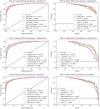Batch-balanced focal loss: a hybrid solution to class imbalance in deep learning
- PMID: 37361550
- PMCID: PMC10289178
- DOI: 10.1117/1.JMI.10.5.051809
Batch-balanced focal loss: a hybrid solution to class imbalance in deep learning
Abstract
Purpose: To validate the effectiveness of an approach called batch-balanced focal loss (BBFL) in enhancing convolutional neural network (CNN) classification performance on imbalanced datasets.
Materials and methods: BBFL combines two strategies to tackle class imbalance: (1) batch-balancing to equalize model learning of class samples and (2) focal loss to add hard-sample importance to the learning gradient. BBFL was validated on two imbalanced fundus image datasets: a binary retinal nerve fiber layer defect (RNFLD) dataset () and a multiclass glaucoma dataset (). BBFL was compared to several imbalanced learning techniques, including random oversampling (ROS), cost-sensitive learning, and thresholding, based on three state-of-the-art CNNs. Accuracy, F1-score, and the area under the receiver operator characteristic curve (AUC) were used as the performance metrics for binary classification. Mean accuracy and mean F1-score were used for multiclass classification. Confusion matrices, t-distributed neighbor embedding plots, and GradCAM were used for the visual assessment of performance.
Results: In binary classification of RNFLD, BBFL with InceptionV3 (93.0% accuracy, 84.7% F1, 0.971 AUC) outperformed ROS (92.6% accuracy, 83.7% F1, 0.964 AUC), cost-sensitive learning (92.5% accuracy, 83.8% F1, 0.962 AUC), and thresholding (91.9% accuracy, 83.0% F1, 0.962 AUC) and others. In multiclass classification of glaucoma, BBFL with MobileNetV2 (79.7% accuracy, 69.6% average F1 score) outperformed ROS (76.8% accuracy, 64.7% F1), cost-sensitive learning (78.3% accuracy, 67.8.8% F1), and random undersampling (76.5% accuracy, 66.5% F1).
Conclusion: The BBFL-based learning method can improve the performance of a CNN model in both binary and multiclass disease classification when the data are imbalanced.
Keywords: class imbalance; convolutional neural networks; deep learning; retina fundus.
© 2023 Society of Photo-Optical Instrumentation Engineers (SPIE).
Figures








References
-
- Johnson J. M., Khoshgoftaar T. M., “Survey on deep learning with class imbalance,” J. Big Data 6(1), 27 (2019).10.1186/s40537-019-0192-5 - DOI
-
- Masko D., Hensman P., “The impact of imbalanced training data for convolutional neural networks,” Independent thesis basic level (bachelor’s degree) (2015). http://urn.kb.se/resolve?urn=urn:nbn:se:kth:diva-166451
-
- Van Hulse J., Khoshgoftaar T., Napolitano A., “Experimental perspectives on learning from imbalanced data,” in ICML ‘07: Proc. 24th Int. Conf. Mach. Learn., pp. 935–942 (2007).10.1145/1273496.1273614 - DOI
-
- Pham T. C., et al. , “Improving skin-disease classification based on customized loss function combined with balanced mini-batch logic and real-time image augmentation,” IEEE Access 8, 150725–150737 (2020).10.1109/ACCESS.2020.3016653 - DOI
-
- Chawla N., Japkowicz N., Kołcz A., “Editorial: special issue on learning from imbalanced data sets,” SIGKDD Explorations 6, 1–6 (2004).10.1145/1007730.1007733 - DOI

